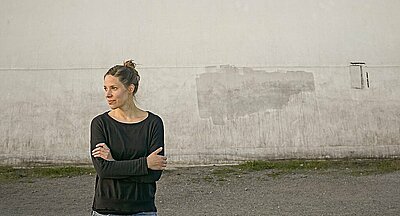Crowd Findings
With a diverse group of dancers, Milla Koistinen outlines questions of resistance and subordination

In her new project "One Next To Me”, chore- ographer Milla Koistinen focuses on tender- ness and violence as physical states. She inves- tigates the contagiousness of physical behav- iour with a group of nine professional and nine non-professional dancers. How do actions transfer from one body to another, and how do physical intentions transform from one state to another? What is the relationship between an individual and a crowd? Here, Milla Koistinen shares some thoughts from during the rehearsal process.
Milla Koistinen
Choreographer
The relationship between the artificial world of the theater space and the outside pedestrian world is definitely something I keep returning to in my work. Most of my work has tried to merge the theater space and the outside, or to let the outside world encroach on or perhaps find its way into the space. This is also linked to my ongoing exploration of reality and fiction and how to merge these different qualities. I try to bring these qualities into the movement and choreography and to see dancing not as abstraction only – movement for the sake of movement –, but I am interested in the human quality on stage.
I think movement should have a purpose so that when you’re watching you have a sense that there’s an intention. By this I don’t mean that the movement should illustrate or represent a psychological development within a character but the spectator should be able to connect with a real exploration in some way. My insistence on intention may also be connected with the fact that I don’t start my process from the body or from movement, rather I start from a source or research and then build material. For example, for my current piece "One Next To Me”, I did research into violence and power structures and here found material in Elias Canetti’s book "Crowds and Power” and documentary material. In the piece these elements are filtered since that is how I am exposed to violence; I read about it and see it in the media but I haven’t directly experienced it even if the threat of it can be very present.
In "One Next To Me”, I bring together professional dancers with non-professionals who have no formal dance training. The group is quite diverse. The youngest is about seven and the oldest about 70 years old and they come from various backgrounds. They have very different qualities in terms of presence on stage: non-professionals are present in the room as themselves and have more of a pedestrian presence on stage. Professional dancers, on the other hand, have a refined stage presence and a different kind of abstract, perhaps poetic quality. They can show a way of moving which is imaginative and not at all how one would move in the street. So it is interesting to combine two kinds of stage presences and see how these different qualities can co-exist in the same piece. And since we are working with performers of different ages we have different generations co-existing on the stage.
Working with different ages also impacts on how I structure the rehearsals. It is important to me to keep the rehearsals playful, for example we balance out the world of the adults and the intense work with games the kids can propose. We try to find material which unites or divides the group. I encourage the performers to influence one another and to observe each other so that we can find the common denominators within the physical qualities of the performers despite their age and background. On the other hand we use their differences in order to create dissonance in the piece.
I often ask the dancers to tell me how the piece ‘looks’ or feels from ‘inside’, or from their perspective. I know that the dancers have information coming from the body and can offer good solutions because the body can give answers. You see things differently when you are actively doing those things yourself. I apply this to my own process as a choreographer: I move between inside and outside when I direct. When I see that the dancers are struggling and don’t find material, I join their improvisation and my own body tells me how something can be developed. I am talking and directing whilst moving with the dancers, so for me I need to do the things and not just watch, but you cannot get the big picture whilst being inside so I have to step out to see the piece.
I work with people who have a strong identity as artists in their own right. It is important to work with people who don’t think they’re just there to execute my ideas, but who have their own world which they want to bring into the work. It brings unexpected solutions and ideas that I myself could not think up or imagine. This applies especially to the moment of structuring the material. We give a lot of space for light and sound, for example, which influences the dramaturgy of the piece to a great extent.